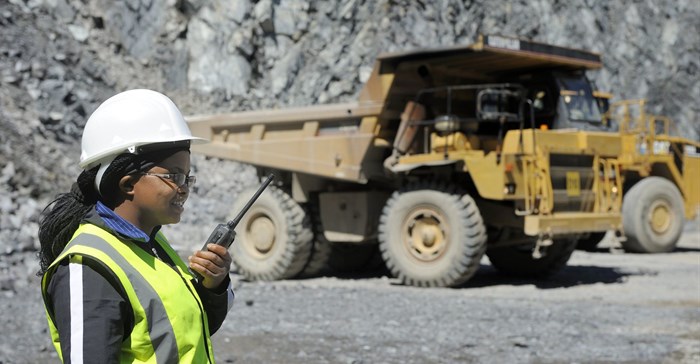
Subscribe & Follow
Advertise your job vacancies
#WomensMonth made possible by

#WomensMonth: Gender equality in mining requires challenging stereotypes
It goes without saying, that, historically, mining has been a very much male-dominated industry. Despite a growing movement toward diversity and inclusion, women are dramatically underrepresented in the sector as a whole, not only in South Africa but around the globe.

Source: Getty/Gallo
While there is legislation aimed at driving gender equality, progress has been slow in achieving this. Promoting gender equality and diversity in mining will take collective effort. Those in leadership positions should empower employees to challenge the stereotypes that exist and to shift mindsets toward a culture of inclusion throughout the industry.
Some statistics
According to a Minerals Council of South Africa report, the number of women working in the mining sector has increased significantly in the past 15 years or so – from around 11,400 in 2002 to around 53,000 women in 2015, increasing to 54,154 in 2018. However, while there has been growth since gender equality legislation became enforceable, this rise has been slow. The statistics show that women represent just 12% of the mining labour force of almost half a million people, and just 16% of top management and 17% of senior management.
This is not a phenomenon that is exclusive to South Africa either. Data compiled for Osler's 2020 Diversity Disclosure Practices report shows that just 16% of directors at Canadian mining companies in 2020 were women, up from 13% in 2019. Globally, fewer than one in five leadership positions in mining are filled by women.
“The mining industry is unfortunately held back by its traditionally patriarchal culture. The above statistics show that the numbers of women in mining are mostly in lower-level positions and this means that cultural change needs to be driven from the top,” says Carol Brandt, metallurgy training manager at Prisma.
Encouraging diversity and inclusion
It is widely acknowledged that diverse and inclusive workplaces are more successful in a world where innovation is a key driver – women think differently and can add value in many areas. While the traditional mindset around mining is that it requires nothing but physical strength and dominance, this has become increasingly less relevant as technology has evolved.
Today, innovation is key to success, and job satisfaction has become a driver for many in the workplace. Female leadership styles lend themselves to this, fostering a more supportive and nurturing environment that in turn drives greater employee engagement and improves motivation and morale. Companies recognise this, but acting on it has proven a challenge.
“Globally, we see plenty of companies spend time planning how they will hire more women in leadership roles without a clear plan to develop and keep them. Companies must establish a culture with models and policies to include women in the workplace,” says Alet Visser, office manager at Prisma.
Fostering a female-friendly environment
Making the mining environment more conducive to a larger proportion of female employees means taking things right back to basics. Women have different needs to men, and policies such as maternity leave, sexual harassment, empowerment, and professional growth are a must. It is also imperative to provide access to childcare and decent housing in mining communities.
Even more basic, perhaps, but often overlooked, is access to the right personal protective equipment (PPE). Women are not the same size or shape as men, and they need gear tailored to their bodies, both for their safety and their dignity.
“Taking it even further back, companies should look at their hiring process, as this could also play a vital role in either encouraging or inhibiting gender equity. The way jobs are advertised, and even where they are advertised, impacts the type of person who will apply for the job,” says Visser.
Shifting paradigms
While promoting gender diversity in mining is a worthy goal, and one that needs to be addressed, it needs to be done in the right way. Management roles may be inherently gender-neutral, even in mining, and women are physically capable of many of the same tasks as men, especially with new technology, but the mindset remains an issue. The gender stereotypes are strong, and the reality is that women and men have different needs.
“In South Africa, there is insufficient published data on the health and safety concerns and issues of women in mining. These include, among others, the availability of welfare facilities underground, physiological changes and psychological vulnerability inherent among women that may affect their health and safety at work, and the impact of shift work on women’s family lives. There may also be resistance by their male counterparts to fully accept and regard women as equal partners,” says Brandt.
Ultimately the aim should not be simply to push numbers and comply with legislation, but to develop career paths for women within the mining sector, with initiatives such as mentorship of women by women. To do this, the culture needs to change, and stereotypes and mindsets need to be challenged. Women and men are not the same, but these differences are what makes the addition of women immensely valuable. By encouraging women to participate more fully in the sector, they can boost innovation and contribute to the growth and ongoing relevance of the industry.
Related
Absa reaffirms commitment to women’s empowerment with the Absa Ladies Invitational 26 Mar 2025 McCann Joburg's Modjadji Mashatola on AME WE Champion jury 14 Mar 2025 Women in leadership: The crucial role of men 11 Mar 2025 #InternationalWomensDay2025: PGA's first female CEO, Koo Govender leads the way in DEI in advertising 7 Mar 2025 #InternationalWomensDay2025: Celebrating Philile Mabolloane, head of Retail: Consumables at Amazon SSA 6 Mar 2025 Open Chair has 12 free Cannes Lions for young women; asks industry to help with costs 17 Feb 2025







